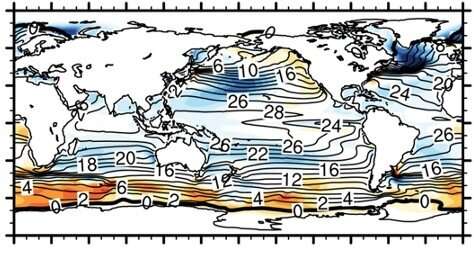Simulated sea surface temperature and its biases by FGOALS-f3-L. Credit: GUO Yuyang
Climate change is a hot topic, with everyone wondering how the climate will change in the future. Since climate change is a slow process, it is hard to study based on short-term observations. Using climate models has become the most common method.
A climate model is a software package running on a supercomputer that can solve the physical formulations that describe variations in the atmosphere, ocean and other Earth systems via numerical algorithms, thus helping scientists to study climate changes.
In recent decades, climate models have developed from simple models to complex systems, and their performance continually improves.
The climate system model FGOALS-f3-L, developed at the State Key Laboratory of Numerical Modeling for Atmospheric Sciences and Geophysical Fluid Dynamics (LASG), Institute of Atmospheric Physics (IAP) of the Chinese Academy of Sciences, is one of the latest climate models in China. It is currently participating in phase 6 of the Coupled Model Intercomparison Project (CMIP6).
Evaluations of the experimental outputs show that the model reasonably simulates climatic elements in historical experiments, including the long-term trends and climatological patterns.
Additionally, improvements are apparent compared with the previous version. For the simulated ocean and sea ice, the most obvious biases are cold biases and overestimation of sea ice in the Arctic.
Prof. YU Yongqiang, the corresponding author of the study, now published in Advances in Atmospheric Sciences, says, "The obvious improvements of this latest model in simulating the climate system are meaningful for us to study climate dynamics and enhance our ability to project climate change, and of course, make new contributions to the development of autonomous climate models in China."
More information: Yuyang Guo et al. Simulation and Improvements of Oceanic Circulation and Sea Ice by the Coupled Climate System Model FGOALS-f3-L, Advances in Atmospheric Sciences (2020). DOI: 10.1007/s00376-020-0006-x
Provided by Chinese Academy of Sciences
























